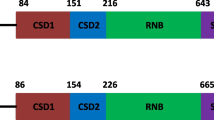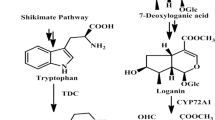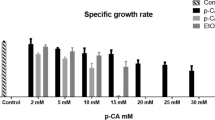Abstract
In a recent study, we established that psychrophilic Pseudomonas syringae (Lz4W) requires trans-monounsaturated fatty acid for growth at higher temperatures (Kiran et al. in Extremophiles, 2004). It was also demonstrated that the cti gene was highly conserved and exhibited high sequence identity with cti of other Pseudomonas spp. (Kiran et al. in Extremophiles, 2004). Therefore it would be interesting to understand the expression of the cti gene so as to unravel the molecular basis of adaptation of microorganisms to high temperature. In the present study, the expression of cti was monitored by RT-PCR analysis during different growth stages and under conditions of high temperature and solvent stress in P. syringae. Results indicated that the cti gene is constitutively expressed during different stages of growth and the transcript level is unaltered even under conditions of temperature and solvent stress implying that the observed increase in trans-monounsaturated fatty acids (Kiran et al. in Extremophiles, 2004) is not under transcriptional control. A putative promoter present in the intergenic region of the metH and cti gene has also been characterized. The translation start site ATG, the Shine-Dalgarno sequence AGGA and the transcription start site “C” were also identified. These results provide evidence for the first time that the cti gene is constitutively expressed under normal conditions of growth and under conditions of temperature and solvent stress thus implying that the Cti enzyme is post-transcriptionally regulated.



Similar content being viewed by others
References
Duilio A, Madonna S, Tutino ML, Pirozzi M, Sannia G, Marino G (2004) Promoters from a cold adapted bacterium: definition of a consensus motif and molecular characterization of UP regulative elements. Extremophiles 8:125–132
Heidelberg JF, Eisen JA, Nelson WC, Clayton RA, Gwinn ML, Dodson RJ, Haft DH, Hickey EK, Peterson JD, Umayam L, Gill SR, Nelson KE, Read TD, Tettelin H and Richardson D, Ermolaeva MD, Vamathevan J, Bass S, Qin H, Dragoi I, Sellers P, McDonald L, Utterback T, Fleishmann RD, Nierman WC, White O (2000) DNA sequence of both chromosomes of the cholera pathogen Vibrio cholerae. Nature 406:477–483
Heipieper HJ, De Bont JAM (1994) Adaptation of Pseudomonas putida S12 to ethanol and toluene at the level of fatty acid composition of membranes. Appl Environ Microbiol 60:4440–4444
Heipieper HJ, Meinhardt F, Segura A (2003) The cis-trans isomerase ofunsaturated fatty acids in Pseudomonas and Vibrio: biochemistry, molecular biology and physiological function of a unique stress adaptive mechanism. FEMS Microbiol Lett 229:1–7
Holtwick R, Meinhardt F, Keweloh H (1997) cis-trans isomerization of unsaturated fatty acids: cloning and sequencing of the cti gene from Pseudomonas putida P8. Appl Environ Microbiol 63:4292–4297
Janiyani KL, Ray MK (2002) Cloning, sequencing and expression of the cold-inducible hutU gene from the Antarctic psychrotrophic bacterium, Pseudomonas syringae. Appl Environ Microbiol 68:1–10
Junker F, Ramos JL (1999) Involvement of the cis/trans isomerase Cti in solvent resistance of Pseudomonas putida DOT-T1E. J Bacteriol 181:5693–5700
Keweloh H, Heipieper HJ (1996) trans-unsaturated fatty acids in bacteria. Lipids 31:129–137
Killian JA, Fabrie CHJP, Baart W, Morein S, de Kruijff B (1992) Effects of temperature variation and phenethyl alcohol addition on acyl chain order and lipid organization in Escherichia coli derived membrane systems. A 2H- and 31P-NMR staudy. Biochim Biophys Acta 1105:253–262
Kiran MD, Prakash JS, Annapoorni S, Dube S, Kusano T, Okuyama H, Murata N, Shivaji S (2004) Psychrophilic Pseudomonas syringae requires trans-monounsaturated fatty acid for growth at higher temperature. Extremophiles 8:401-410
Livak KJ, Schmittgen TD (2001) Analysis of relative gene expression data using real-time quantitative PCR and the 2−Δ Δ CT method. Methods 25:402-408
Makula RA (1978) Phospholipid composition of methane-utilizing bacteria. J Bacteriol 134:771–777
Morita N, Shibahara A, Yamamoto K, Shinkai K, Kajimoto G, Okuyama H (1993) Evidence for cis–trans isomerization of a double bond in the fatty acids of the psychrophilic bacterium Vibrio sp. strain ABE-1. J Bacteriol 175:916–918
Okuyama H, Sasaki S, Higashi S, Murata N (1990) A trans-unsaturated fatty acid in a psychrophilic bacterium, Vibrio sp. strain ABE-1. J Bacteriol 172:3515–3518
Okuyama H, Okajima N, Sasaki S, Higashi S, Murata N (1991) The cis/trans isomerization of the double bond of a fatty acid as a strategy for adaptation to changes in ambient temperature in the psychrophilic bacterium, Vibrio sp. strain ABE-1. Biochim Biophys Acta 1084:13–20
Pedrotta V, Witholt B (1999) Isolation and characterization of the cis-trans- unsaturated fatty acid isomerase of Pseudomonas oleovorans GPo12. J Bacteriol 181:3256–3261
Pinkart HC, White DC (1997) Phospholipid biosynthesis and solvent tolerance of Pseudomonas putida strains. J Bacteriol 179:4219–4226
Ramos JL, Duque E, Rodriguez-Herva JJ, Godoy P, Haidour A, Reyes F, Fernandez-Barrero A (1997) Mechanisms for solvent tolerance in bacteria. J Biol Chem 272:3887–3890
Ramos JL, Gallegos MT, Marques S, Ramos-Gonzalez MI, Espinosa-Urgel M, Segura A (2001) Responses of Gram-negative bacteria to certain environmental stressors. Curr Opin Microbiol 4:166–171
Ray MK, Seshu Kumar G, Shivaji S (1994a) Phosphorylation of membrane proteins in response to temperature in an Antarctic Pseudomonas syringae. Microbiology 140:3217–3223
Ray MK, Seshu Kumar G, Shivaji S (1994b) Phosphorylation of lipopolysaccharides in the Antarctic psychrotroph Pseudomonas syringae: a possible role in temperature adaptation. J Bacteriol 176:4243–4249
Ray MK, Seshu Kumar G, Shivaji S (1994c) Tyrosine phosphorylation of a cytoplasmic protein from the Antarctic psychrotrophic bacterium Pseudomonas syringae. FEMS Microbiol Lett 122:49–54
Santos PM, Blatny JM, Di Bartolo I, Valla S, Zennaro E (2000) Physiological analysis of the expression of the styrene degradation gene cluster in Pseudomonas fluorescens ST. Appl Environ Microbiol 66:1305–1310
Shivaji S, Rao NS, Saisree L, Sheth V, Reddy GSN, Bhargava PM (1989) Isolation and identification of Pseudomonas spp. from Schirmacher Oasis, Antarctica. Appl Environ Microbiol 55:767–770
Stover CK, Pham XQ, Erwin AL, Mizoguchi SD, Warrener P, Hickey MJ, Brinkman FS, Hufnagle WO, Kowalik DJ, Lagrou M, Garber RL, Goltry L, Tolentino E, Westbrock-Wadman S, Yuan Y, Brody LL, Coulter SN, Folger KR, Kas A, Larbig K, Lim R, Smith K, Spencer D, Wong GK, Wu Z, Paulsen IT, Reizer J, Saier MH, Hancock RE, Lory S, Olson MV (2000) Complete genome sequence of Pseudomonas aeruginosa PA01, an opportunistic pathogen. Nature 406:959–964
von Wallbrunn A, Richnow HH, Neumann G, Meinhardt F, Heipieper HJ (2003) Mechanism of cis–trans isomerization of unsaturated fatty acids in Pseudomonas putida. J Bacterol 185:1730–1733
Weber FJ, Isken S, de Bont JA (1994) Cis/trans isomerization of fatty acids as a defence mechanism of Pseudomonas putida strains to toxic concentrations of toluene. Microbiology 140:2013–2017
Acknowledgements
This work was supported by a grant from India–Japan Cooperative Science Programme of the Department of Science and Technology, Government of India and the Japanese Society for Promotion of Science, Government of Japan, to SS. MDK would like to thank the Council of Scientific and Industrial Research, New Delhi, Government of India, for a Junior and Senior Research Fellowship.
Author information
Authors and Affiliations
Corresponding author
Additional information
Communicated by K. Horikoshi
Rights and permissions
About this article
Cite this article
Kiran, M.D., Annapoorni, S., Suzuki, I. et al. Cis–trans isomerase gene in psychrophilic Pseudomonas syringae is constitutively expressed during growth and under conditions of temperature and solvent stress. Extremophiles 9, 117–125 (2005). https://doi.org/10.1007/s00792-005-0435-6
Received:
Accepted:
Published:
Issue Date:
DOI: https://doi.org/10.1007/s00792-005-0435-6




